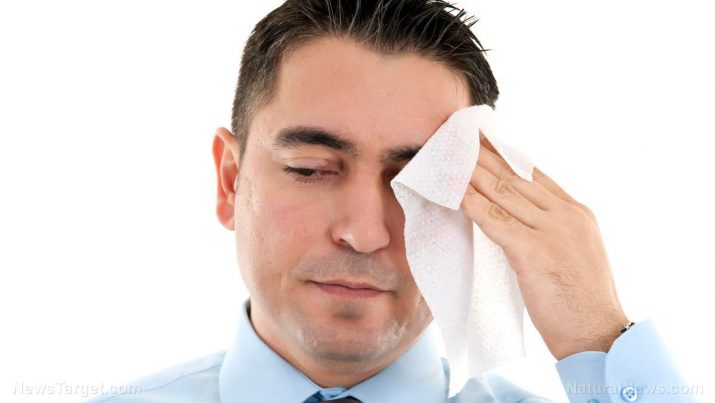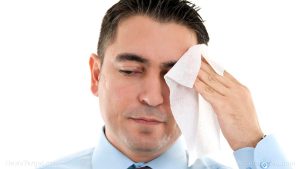
Hyperhidrosis – causes, side effects and treatments at NaturalPedia.com
Saturday, April 28, 2018 by Ralph Flores
http://www.naturalpedia.com/hyperhidrosis-causes-side-effects-and-treatments-at-naturalpedia-com.html

Hyperhidrosis, commonly known as excessive sweating, is a fairly common disorder that has accounted for many uncomfortable and unpleasant situations. While primary hyperhidrosis can happen to anyone, even in healthy individuals, secondary hyperhidrosis is much less common and can be caused by taking certain types of medication, serious chronic conditions, neurological disorders, effects of facial surgery, and anxiety disorder. In the U.S., at least three percent suffer from the condition, with half of those affected having axillary hyperhidrosis (excessive sweating in the underarms). In particular, excessive underarm sweating begins during puberty, and palm and sole sweating can be detected even in early childhood. Hyperhidrosis persists throughout a person’s life if left untreated.
On a practical level, excessive sweating is a source of embarrassment, not to mention stained clothing due to sweat. It also makes gripping difficult; thus, activities such as holding a pen, gripping a steering wheel, and even shaking hands, could prove to be arduous. Hyperhidrosis can even complicate business and social settings as well.

Known risk factors and symptoms of hyperhidrosis
Sweating, in general, is the body’s natural response to stay cool. People usually sweat when it is warm, during exercise, or when faced with situations that cause them to be nervous, angry, embarrassed, or afraid.
However, experts believe that people with hyperhidrosis may have overactive sweat glands, which causes them to sweat uncontrollably and profusely. If the condition affects a person’s hands, feet, and armpits, it’s called primary or focal hyperhidrosis.
The cause of the condition remains unclear, with some suggesting that it could be an inherent trait.
If another medical condition causes excessive sweating, it’s called secondary hyperhidrosis. This can be characterized by either localized sweating in one area or one which affects the whole body. Some conditions cause secondary hyperhidrosis. These include anxiety disorders, cancer and carcinoid syndromes, certain medicine, heart and lung diseases, Parkinson’s disease, injuries to the spinal cord, and strokes.
The landmark symptom of hyperhidrosis is sweating profusely.
Body systems affected by hyperhidrosis
The following complications are likely to happen if hyperhidrosis is left untreated:
- Nail infections – In particular, toenail infections
- Warts – These are skin growths caused by the human papillomavirus (HPV)
- Bacterial infections – This can happen around the hair follicles and between the toes
- Heat rash (prickly heat, miliaria) – This condition is characterized by an itchy, red skin rash that feels like it’s stinging. This occurs when the sweat glands are blocked, leaving sweat trapped under the skin.
- Psychological impact – Hyperhidrosis can negatively impact a person’s self-confidence and may even cause anxiety, emotional stress, social withdrawal, and even depression.
Food items or nutrients that may prevent or relieve hyperhidrosis
According to natural cure website Earth Clinic, there are some food items that a person could take to get relief from hyperhidrosis. These include activated charcoal, apple cider vinegar, and honey. Aside from decreasing sweat production, these may also help with issues related to the condition, in particular, odor.
Treatment and management options for hyperhidrosis
Treating hyperhidrosis depends on a variety of factors: Where is it located? What methods have been done prior to the treatment? What is the patient’s medical history? In particular, if he or she has a pre-existing condition – hormonal, metabolic, or tumor-related causes – for acquired hyperhidrosis, these conditions are taken into consideration as well. If exposure to medication caused it, healthcare professionals may switch it to a different class or family to alleviate the symptoms.
The use of topical antiperspirants is usually the first step in treating the disease. However, treatments are not consecutive as this can cause local irritation of the skin. If the procedure is successful, the application is reduced to once a week or even two weeks.
The next phase it the use of botulinum toxin injection (Botox) on the palms and soles. This process is very painful – some even require the use of nerve blockers to complete the procedure – but the results last longer than that of topical antiperspirants.
Medication is used when hyperhidrosis is caused either by antidepressant use, general anxiety, or even public speaking. There are laser therapies that have been reported to help hyperhidrosis, but these are yet to be commercially available. Surgery is another option to treat the condition, but the procedure, aside from being expensive, is prone to problems.
Where to learn more
- Hyperhidrosis – 10 Home Remedies, For Stopping Excessive Sweat
- How To Sweat Less In A Hot Weather
- Are You Drinking Too Much Water? – How to Avoid Water Intoxication
- Boost hydration, alkalize, and clear skin with fresh lemon water
- Stress and Toxicity: What’s Going On?
Summary
Hyperhidrosis is a fairly common disorder characterized by profuse and uncontrollable sweating.
If the condition affects a person’s hands, feet, and armpits, it’s called primary or focal hyperhidrosis.
If another medical condition causes excessive sweating, it’s called secondary hyperhidrosis.
Experts believe that people with hyperhidrosis may have overactive sweat glands, which causes them to sweat uncontrollably and profusely.
There are some food items that a person could take to get relief from hyperhidrosis and also help with issues related to the condition, in particular, odor.
Sources include:
Tagged Under: Tags: hyperhidrosis





